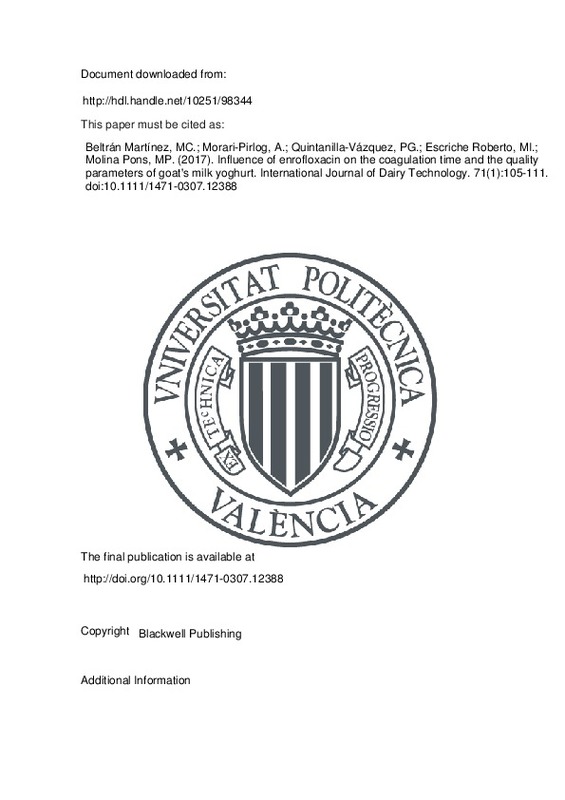Regulation UE 37/2010 of 22 December 2009 on pharmacologically active substances and their classification regarding maximum residue limits in foodstuffs of animal origin Official Journal European Union
Adetunji, V. O. (2011). Effects of Processing on Antibiotic Residues (Streptomycin, Penicillin−G and Tetracycline) in Soft Cheese and Yoghurt Processing Lines. Pakistan Journal of Nutrition, 10(8), 792-795. doi:10.3923/pjn.2011.792.795
Beltrán, M. C., Berruga, M. I., Molina, A., Althaus, R. L., & Molina, M. P. (2015). Performance of current microbial tests for screening antibiotics in sheep and goat milk. International Dairy Journal, 41, 13-15. doi:10.1016/j.idairyj.2014.09.007
[+]
Regulation UE 37/2010 of 22 December 2009 on pharmacologically active substances and their classification regarding maximum residue limits in foodstuffs of animal origin Official Journal European Union
Adetunji, V. O. (2011). Effects of Processing on Antibiotic Residues (Streptomycin, Penicillin−G and Tetracycline) in Soft Cheese and Yoghurt Processing Lines. Pakistan Journal of Nutrition, 10(8), 792-795. doi:10.3923/pjn.2011.792.795
Beltrán, M. C., Berruga, M. I., Molina, A., Althaus, R. L., & Molina, M. P. (2015). Performance of current microbial tests for screening antibiotics in sheep and goat milk. International Dairy Journal, 41, 13-15. doi:10.1016/j.idairyj.2014.09.007
BERRUGA, M. I., NOVÉS, B., MOLINA, M. P., ROMÁN, M., & MOLINA, A. (2008). Influence of cephalosporins on the coagulation time of yogurt made from ewes’ milk. International Journal of Dairy Technology, 61(4), 372-378. doi:10.1111/j.1471-0307.2008.00421.x
Elsheikh, H. ., Taha, A. A. ., Khalafallah, A. ., & Osman, I. A. . (2002). Disposition kinetics of enrofloxacin (Baytril 5%) in sheep and goats following intravenous and intramuscular injection using a microbiological assay. Research in Veterinary Science, 73(2), 125-129. doi:10.1016/s0034-5288(02)00020-6
Grunwald, L., & Petz, M. (2003). Food processing effects on residues: penicillins in milk and yoghurt. Analytica Chimica Acta, 483(1-2), 73-79. doi:10.1016/s0003-2670(02)01405-8
Güler-Akın, M. B., & Akın, M. S. (2007). Effects of cysteine and different incubation temperatures on the microflora, chemical composition and sensory characteristics of bio-yogurt made from goat’s milk. Food Chemistry, 100(2), 788-793. doi:10.1016/j.foodchem.2005.10.038
Haenlein, G. F. . (2004). Goat milk in human nutrition. Small Ruminant Research, 51(2), 155-163. doi:10.1016/j.smallrumres.2003.08.010
Lolo, M., Pedreira, S., Miranda, J. M., Vázquez, B. I., Franco, C. M., Cepeda, A., & Fente, C. (2006). Effect of cooking on enrofloxacin residues in chicken tissue. Food Additives and Contaminants, 23(10), 988-993. doi:10.1080/02652030600904894
MOAYEDNIA, N., EHSANI, M. R., EMAMDJOMEH, Z., & MAZAHERI, A. F. (2009). Effect of refrigerated storage time on the viability of probiotic bacteria in fermented probiotic milk drinks. International Journal of Dairy Technology, 62(2), 204-208. doi:10.1111/j.1471-0307.2009.00473.x
Senaka Ranadheera, C., Evans, C. A., Adams, M. C., & Baines, S. K. (2012). Probiotic viability and physico-chemical and sensory properties of plain and stirred fruit yogurts made from goat’s milk. Food Chemistry, 135(3), 1411-1418. doi:10.1016/j.foodchem.2012.06.025
Ribeiro, A. C., & Ribeiro, S. D. A. (2010). Specialty products made from goat milk. Small Ruminant Research, 89(2-3), 225-233. doi:10.1016/j.smallrumres.2009.12.048
Roca, M., Castillo, M., Marti, P., Althaus, R. L., & Molina, M. P. (2010). Effect of Heating on the Stability of Quinolones in Milk. Journal of Agricultural and Food Chemistry, 58(9), 5427-5431. doi:10.1021/jf9040518
Sah, B. N. P., Vasiljevic, T., McKechnie, S., & Donkor, O. N. (2015). Effect of refrigerated storage on probiotic viability and the production and stability of antimutagenic and antioxidant peptides in yogurt supplemented with pineapple peel. Journal of Dairy Science, 98(9), 5905-5916. doi:10.3168/jds.2015-9450
Sierra, D., Contreras, A., Sánchez, A., Luengo, C., Corrales, J. C., Morales, C. T., … Gonzalo, C. (2009). Short communication: Detection limits of non-β-lactam antibiotics in goat’s milk by microbiological residues screening tests. Journal of Dairy Science, 92(9), 4200-4206. doi:10.3168/jds.2009-2101
Stelios, K., & Emmanuel, A. (2004). Characteristics of set type yoghurt made from caprine or ovine milk and mixtures of the two. International Journal of Food Science and Technology, 39(3), 319-324. doi:10.1111/j.1365-2621.2004.00788.x
TOLLEFSON, L., & KARP, B. (2004). Human health impact from antimicrobial use in food animals. Médecine et Maladies Infectieuses, 34(11), 514-521. doi:10.1016/s0399-077x(04)00182-9
Vargas, M., Cháfer, M., Albors, A., Chiralt, A., & González-Martínez, C. (2008). Physicochemical and sensory characteristics of yoghurt produced from mixtures of cows’ and goats’ milk. International Dairy Journal, 18(12), 1146-1152. doi:10.1016/j.idairyj.2008.06.007
ZORRAQUINO, M. A., ROCA, M., FERNANDEZ, N., MOLINA, M. P., & ALTHAUS, R. (2008). Heat Inactivation of β-Lactam Antibiotics in Milk. Journal of Food Protection, 71(6), 1193-1198. doi:10.4315/0362-028x-71.6.1193
[-]







![[Cerrado]](/themes/UPV/images/candado.png)


